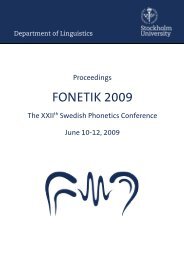The Double Passive in Swedish - Institutionen för lingvistik ...
The Double Passive in Swedish - Institutionen för lingvistik ...
The Double Passive in Swedish - Institutionen för lingvistik ...
You also want an ePaper? Increase the reach of your titles
YUMPU automatically turns print PDFs into web optimized ePapers that Google loves.
5. Results<br />
5.1 <strong>The</strong> corpus study<br />
5.1.1 Primary collected data<br />
In order to collect data (matrix verbs) for the secondary searches, ten of the most frequent equi verbs<br />
of the corpora were chosen 16 out of the primary searches for further analysis. Note that frequencies of<br />
equi verbs <strong>in</strong> the primary searches (cf. Table 1) were not necessarily part of a <strong>Double</strong> <strong>Passive</strong><br />
construction.<br />
<strong>The</strong> over-all frequency of the ten chosen equi verbs (212 675) formed 0.0314 % of the tokens of the<br />
81 chosen corpora. <strong>The</strong> distribution of each of the ten matrix verbs (V mtx ) <strong>in</strong>dividually is shown <strong>in</strong><br />
(Table 1):<br />
Table 1. <strong>The</strong> over-all frequency of the 10 chosen equi verbs <strong>in</strong> the<br />
81 Corpora selected <strong>in</strong> Korp.<br />
V mtx Frequency of <strong>in</strong>dividual<br />
V mtx <strong>in</strong> 81 corpora.<br />
%<br />
1 ‘avse’ (‘<strong>in</strong>tend’) 13 672 6.43<br />
2 ‘beräkna’ (‘calculate’) 27 163 12.77<br />
3 ‘<strong>för</strong>eslå’ (‘suggest’) 21 500 10.11<br />
4 ‘<strong>för</strong>vänta’ (‘expect’) 15 671 7.37<br />
5 hota (‘threat’) 12 094 5.69<br />
6 ‘planera’ (‘plan’) 14 960 7.03<br />
7 ‘påstå’ (‘argue’) 9 406 4.42<br />
8 ‘riskera’ (‘risk’) 554 0.26<br />
9 ‘tillåta’ (‘allow’) 12 403 5.83<br />
10 ‘tv<strong>in</strong>ga’ (‘force’) 85 252 40.09<br />
Total: 212 675 100<br />
5.1.2 Full and bare <strong>in</strong>f<strong>in</strong>itives<br />
Now, <strong>in</strong> the primary searches, the equi verbs (4 691) formed 1.952 % of totally 240 220 tokens of the<br />
6 collected data files. <strong>The</strong> high total per cent age of equi verbs was due to the high precision of the<br />
search str<strong>in</strong>gs, where the searches where aimed at specific verb-verb constructions.<br />
A total frequency of 1 905 <strong>Double</strong> <strong>Passive</strong>s constructions was documented. <strong>The</strong> distribution of each of<br />
the ten verbs with<strong>in</strong> the search str<strong>in</strong>gs presented <strong>in</strong> (Table 2). <strong>The</strong> total per cent age of the ten matrix<br />
verbs (V mtx ) occurr<strong>in</strong>g with bare <strong>in</strong>f<strong>in</strong>itives (V mtx + V <strong>in</strong>f ) was 57.69 %, as compared to 42.31 % <strong>in</strong><br />
occurrence with full <strong>in</strong>f<strong>in</strong>itives (V mtx + IE + V <strong>in</strong>f ).<br />
16 Note that the 10 selected verbs were chosen manually. Some of the most frequent matrix verbs were<br />
considered unclear cases e.g. ’behöva’ (need’) regard<strong>in</strong>g the lexical properties of the verbs, and<br />
therefore excluded.<br />
30

















